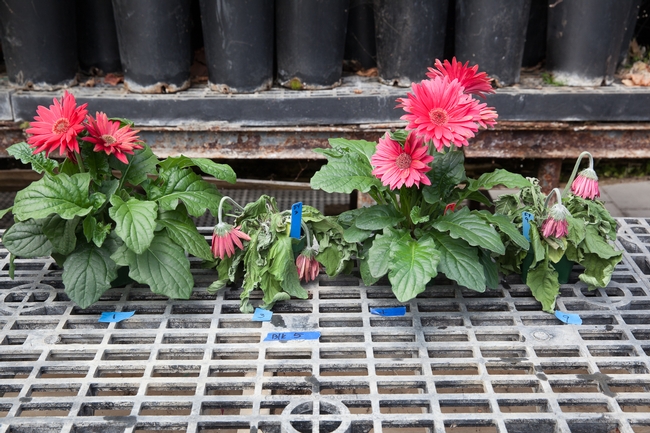Question: Which of the four Gerbera plants above are infected with a deadly plant pathogen?
Answer: Most observers would say the badly wilted plants, that is, the second and fourth from the left. However, the correct answer is the second, fourth, and the healthy-looking third plant from the left!
An astonishing observation was made recently in a series of experiments to evaluate the efficacy of several conventional and biological fungicides to control disease caused by the deadly plant pathogen, Phytophthora cryptogea. This soil- inhabiting pathogen begins its deadly course by infecting susceptible roots. It develops up to the root crown near the soil line, the plant wilts, and eventually dies. However, in the experiments, Gerbera were mostly free of any above-ground and root symptoms when a conventional fungicide, mefenoxam (Subdue Maxx ®), was applied to the soil several days after the soil was infested with P. cryptogea. At the end of the experiment, however, the pathogen was recovered from healthy looking root balls when the roots were cultured in the laboratory (Yes, the third plant above and others like it!). Mefenoxam was stopping or slowing the development of the disease once it was initiated but did not kill the pathogen. Of the other 7 fungicides tested, no other fungicide masked the existence of root infection in this way.
Normally fungicides are applied before disease occurs to prevent infection. But in another twist to the story, when mefenoxam was applied before P. cryptogea was applied to the soil, it just did not work well, and plants died at the end of the experiments. As expected, other fungicides controlled disease, some of them very well, when applied before the pathogen was applied to the soil.
This provides some new information about the unique mechanism of action of mefenoxam. Also, since mefenoxam treatment of plants with infected roots could still produce plants of high quality, they could easily be inadvertently harvested and shipped in the trade. This “masking of symptoms” is thought to occur in the trade but until now has not been experimentally demonstrated for Phytophthora root infections. Still to be determined: does the mefenoxam suppressive activity wear off and, if so, could disease symptoms begin to develop (perhaps as a potted flowering plant on the dining room table or planted in the landscape). This also has significant implications for our nurseries that produce native plants for restoration purposes.
Could these symptomless carriers of Phytophthora be planted in sensitive natural areas and be sources of inoculum for new disease in native plants? The potential ecological problem of releasing new Phytophthora species, disease symptoms, and their management is described in several published newsletter articles. http://ucnfanews.ucanr.edu/newsletters/Download_UCNFA_News_as_PDF70423.pdf
This is the first post of the new Nursery and Flower Grower blog. It will be a weekly post covering subjects about horticulture and pest management for the grower and associated industry. My goal is to produce concise, interesting, and useful articles that cover a single subject, idea, or news. You will see lots of images that I have taken over my 38-year career as a Farm Advisor, and some new video clips too. Please feel free to subscribe to this blog by clicking the “subscribe” link in the upper right-hand portion of this web page.
Next week: More on the Evaluation of Phytophthora fungicides and biological control.
